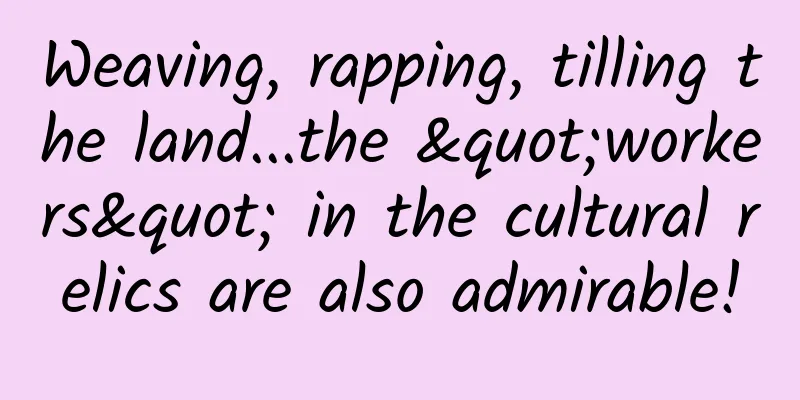Weaving, rapping, tilling the land...the "workers" in the cultural relics are also admirable!

|
Diligence is a traditional virtue of the Chinese nation. As another May Day approaches, we might as well look back at history, look for the figures of ancient workers from cultural relics, appreciate their ordinariness and extraordinaryness, and appreciate their wisdom and creativity. Working women in "Dou Lin Tu" People often say that "women hold up half the sky", and this was also true in ancient times. In the Tang Dynasty, women had a very high social status. According to historical records, there was a mutual aid organization called "Women's Society" among working women in the Tang Dynasty. This organization did not rely on the government and operated completely independently. It had a group of leaders, such as the head of the group, the recorder, and the elders. Its purpose was to "help each other in times of danger and save each other in times of difficulty." Under the influence of the open-minded thinking of the Tang Dynasty, women became the most beautiful scenery of that era. Among the paintings that have been passed down through the ages, there is one that clearly records the elegance of women in the Tang Dynasty working together. This "Double Silk Picture" created by Tang Dynasty painter Zhang Xuan is a meticulous and heavily colored painting, 37 cm in length and 145.3 cm in width. "Lian" is a kind of silk fabric. When it is just woven, it is hard in texture. It must be boiled, bleached, and then pounded with a pestle to become soft and white. The long scroll "Double Silk Picture" depicts a total of twelve characters, which are divided into three groups of scenes according to the labor process: pounding silk, weaving, and ironing. The first group depicts four people pounding silk with a wooden pestle; the second group depicts two people, one sitting on a carpet to sort out the threads, and the other sitting on a stool to sew, forming a weaving scene; the third group is a scene of several people ironing, and there is also a girl running around mischievously from under the cloth. The characters in the painting move naturally and the details are vividly portrayed. The woman pulls the silk and slightly steps back and leans back, showing that the author observes meticulously. This painting has delicate and vigorous lines, rich colors, and plump figures, reflecting the typical style of Tang Dynasty ladies' paintings. "Dou Lian Tu" is an important folk painting in the heyday of the Tang Dynasty, which has a profound influence on later paintings. The existing "Dou Lian Tu" is believed to be a copy of Song Huizong Zhao Ji, which was originally kept in the Old Summer Palace. After the British and French allied forces "burned the Old Summer Palace" in 1860, the painting was looted and lost overseas. It is now kept in the Boston Museum in the United States. Figurine of a farmer holding a hoe and dustpan, Han Dynasty The Han Dynasty was a time of extravagant burials, and officials of all ranks in the feudal ruling class wanted to take the things they had enjoyed in life with them to the underworld after their death. In addition to jewelry and jade ornaments, the burial objects also included pottery figurines based on slaves, servants, and farmers. A type of figurine holding a hoe and a dustpan has been unearthed in many places in my country. Its image is based on a farmer in the Han Dynasty. The most famous one is kept in the China Agricultural Museum. The figurine is 74 cm tall, wearing a straw hat, holding a hoe in one hand and a dustpan in the other, with a long knife on his waist and straw sandals on his feet. His facial expression is vivid, with a knowing smile on his lips, his trouser legs rolled up high, and his strong feet show the image of an optimistic, hardworking, kind and amiable worker. The wooden-handled iron-mouthed hoe was a common earth-moving tool in the Han Dynasty, equivalent to the later shovel, used for deep plowing. The hoe was also needed in earthwork projects such as dredging rivers, building earth platforms, and building walls. It is worth noting that the farmer has a very conspicuous long knife on his waist. Why did the farmers in the Han Dynasty wear knives? The academic community generally believes that these farmers should not be ordinary tenants, but also serve as servants of the landlords. According to the "Monthly Orders of the Four People" written by Cui Shi, an agronomist in the Eastern Han Dynasty, since Emperor Guangwu of the Han Dynasty Liu Xiu implemented the new measure of measuring land, the private armed forces of the powerful families have been composed of farmers. Whenever there is a shortage of food in February and March or when it is cold in August and September, the farm owners often gather some farmers to repair the gates and set up guards to defend against "the bandits who steal grass during spring hunger"; or repair the five weapons and practice war shooting to prevent "the bandits who are cold and poor". Later, the scale of this private armed force of the powerful families gradually expanded, and they formed "troops" according to the military organization, recruited soldiers, expanded armaments, dominated one side, and thus formed local separatist forces. Figurines of Han Dynasty Playing Drums and Singing Rap is an important art form created by the Chinese working people. There are more than 340 types of rap art in my country, which can be described as a hundred flowers blooming. According to historical records, as early as the Han Dynasty, rap performances were extremely popular among the people. The actors of the Han Dynasty mainly performed teasing, funny and satirical performances to win the smiles of the host and the audience. They often accompanied the host and performed impromptu performances to entertain the host at any time. During the performance, they usually sang while beating drums. At that time, the royal family, nobles, and wealthy officials kept actors and actresses. For example, Emperor Wu of the Han Dynasty "there was no shortage of laughs from actors and dwarfs"; Prime Minister Tian Fen "loved actors and actresses and skilled craftsmen"; Han prose writer Huan Kuan said in "Salt and Iron Discussions: Scattered Insufficiency": "The rich prayed to famous mountains and looked at mountains and rivers. They beat drums with oxen and played with actors and actresses." These can all be used as evidence. In the Han Dynasty stone reliefs of music, dance and acrobatics, we often see performers with short stature, naked upper bodies and funny movements. There are also many pottery figurines of this kind unearthed in Han tombs, which show the popularity of comedian performances at that time. The Han Dynasty drum-beating and rapping figurine was unearthed from the Eastern Han Dynasty cliff tomb in Tianhui Mountain, Chengdu, Sichuan. The figurine is 55 cm tall and made of gray clay pottery. The original painting on the figurine has now fallen off. The pottery figurine is squatting on the ground, with the right leg raised, a round flat drum under the left arm, and a drumstick in the right hand as if beating it. The figurine has an open mouth and laughs heartily. The artist captured the most exciting rapping movements of the rap artist, and used exaggerated body shapes and facial expressions to highlight the artistic image. The character is portrayed very vividly and vividly, which resonates greatly with the audience. The Han Dynasty Drumming and Singing Figurines are now in the collection of the National Museum of China. It is not only an outstanding work in the history of Chinese sculpture art, but also an important physical material in the history of Chinese folk art. Peddler The prosperous scene of the Northern Song capital Bianjing in the Qingming Riverside Scene by the Song Dynasty painter Zhang Zeduan is impressive. In fact, not only in the city, but also in the countryside during the Song Dynasty, there were peddlers walking around. These mobile peddlers were called "peddlers". There is a kind of figure folk painting called "peddler painting" in Song Dynasty paintings. The most famous one was created by the Southern Song Dynasty painter Li Song. This painting is ink on silk, 25.3 cm in height and 70.3 cm in width. In the picture, a peddler is carrying a load of groceries on his shoulders, bending over under the heavy load, and the cheering children are running around to tell each other, their joy is beyond words. There are many items on the load, from pots and bowls, dishes, children's toys to fruits and cakes. The peddlers walk through the streets and alleys, and a load is like a small department store. The peddlers not only bring the goods people need to remote villages, but also bring all kinds of novel things. Li Song depicted such a scene in the picture. The painter used the theme of the peddler to show a side of the life of the market in the Southern Song Dynasty. The shaping of the characters in the picture mainly relies on line drawing, and the delicate strokes are supplemented by elegant colors, making the picture simple and calm. The dynamics of the characters are distinct and no one is the same, showing the painter's realistic skills. The meticulous depiction of the complex but not chaotic goods shows Li Song's skill in "special boundary painting". However, Li Song's "The Peddler" also has limitations, because he was a court painter and most of his paintings were for the court, so some of the items in the picture were owned by the court and could not fully and truly reflect the lives of civilians. This painting of Li Song, "The Peddler", is now in the collection of the Palace Museum in Beijing. It is inscribed: "Painted by Li Congshun's son Song in the year of Xinwei in Jiading." There is also a seven-character poem inscribed by Emperor Qianlong of the Qing Dynasty. It is understood that there are a total of four pieces of Li Song's "The Peddler" in museums around the world. In addition to the small horizontal scroll in the collection of the Palace Museum, the collections of the National Palace Museum in Taipei, the Metropolitan Museum of Art in the United States and the Cleveland Museum of Art in the United States are all round fans. |
<<: How does a QR code work? What do the black and white squares represent? | Digital Literacy
>>: 7 kinds of "aging agents" hidden in daily food, try to avoid them!
Recommend
Holding back tears increases the risk of 3 diseases! Tears also have these unexpected benefits
"It's not a sin for men to cry." Wh...
4K smart TVs are not worthy of their name and ecological shortcomings restrict large-scale application
In the past two months, the smart TV market has b...
Google Glass: I'm previewing the future, but you're talking about life and death
Google Glass, once a magical device worshipped by...
How much does it cost to customize a luggage app in Baoding?
How much is the quotation for customized luggage ...
Thinking + sense of rhythm + refinement, see how excellent operations widen the gap with ordinary operations?
In this article, we will talk about the differenc...
A few "eggs" actually facilitated the "return to one's roots" across billions of years?
Recently, "National Science Review" pub...
Regarding VR social networking, you need to understand these five issues
VR social networking has become quite popular rec...
How to turn users who hate your product into the most loyal ones
During my short 5-year operation career, I spent ...
Xiaohongshu promotion and operation plan!
At the beginning, my purpose of operating Xiaohon...
BYD's fifth-generation DM technology and Qin L DM-i and Haibao 06 DM-i are launched, ushering in the era of fuel consumption 2
On May 28, BYD held a press conference for the fi...
How do emerging social tools break the monetization curse? Here are 3 suggestions
Meitu XiuXiu, which is considered to best represe...
The "core" of the watermelon is definitely true love! Why is the middle of the watermelon the most delicious? |Expo Daily
Why is the middle of a watermelon the most delici...
Choose C for all the questions you don't know in the exam. Metaphysics or truth? Forget it...
I wonder if you have ever heard of this kind of m...
Brand Marketing Integration Path
With the in-depth development of mobile Internet ...









